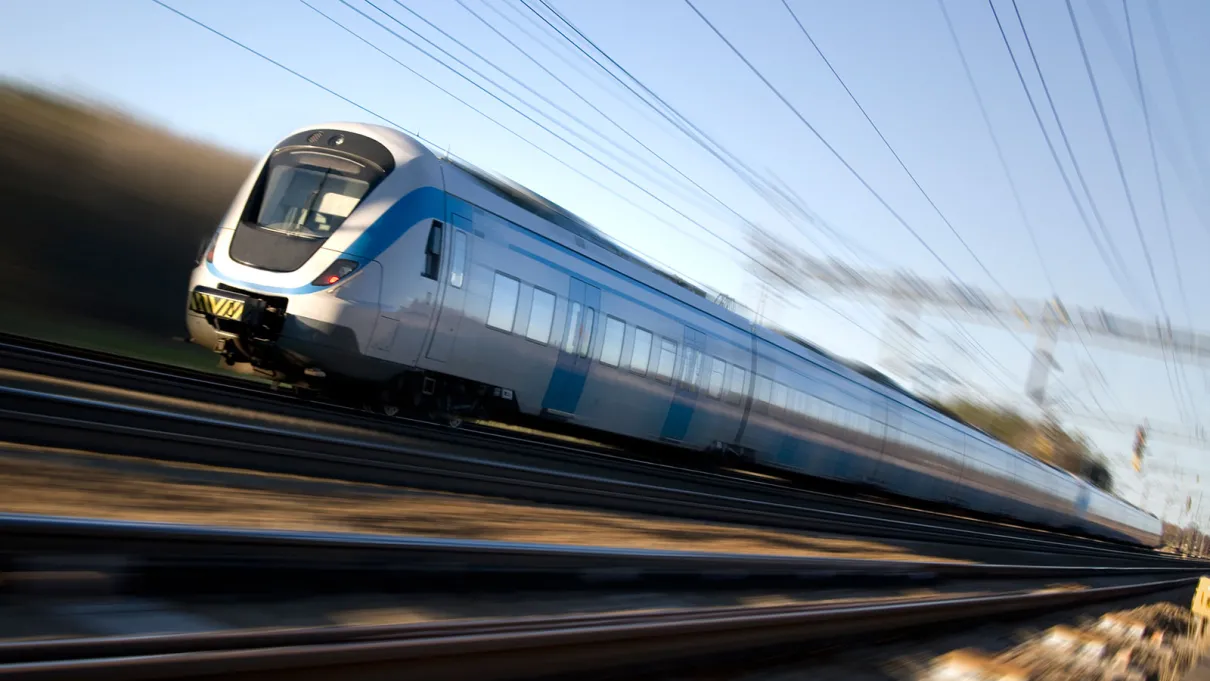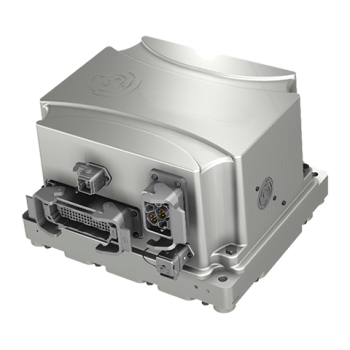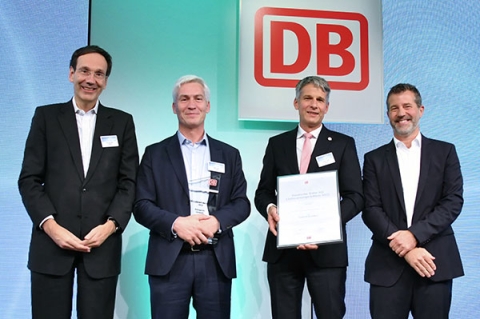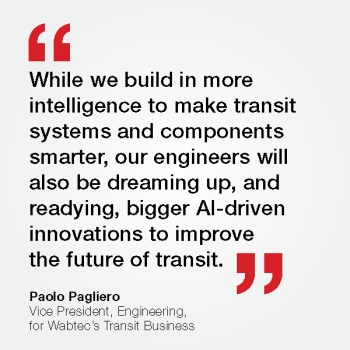
Transit Revolution: Three Game-Changing Innovations
In its 155th year, the Wabtec innovation engine shows no signs of letting up. Look no farther than the company’s Transit business.
Wabtec is blessed. With roots tracing back to Westinghouse, Edison, and Faiveley, the company and its approximately 5,000 engineers literally stand on the shoulders of those engineering giants. But history only gets a Fortune 500 company so far. What today’s Wabtec and its Transit division share with its famous forebears is a track record of breakthrough innovation and continuous improvement.
“What I see in the recent history of innovation at Wabtec Transit is an ability to produce both ‘big bang’ technological advancements that move our industry and incremental improvements across a wide range of systems and components that continually benefit transit rail operators and builders around the world,” says Paolo Pagliero, Vice President, Engineering for Wabtec’s Transit business.
Innovation in context
These innovations, both big and small, are shaped by what Pagliero sees as three constants that ground ‘invention’ in practical delivery:
- Do more with less: Provide advanced functionality, safely and reliably, in less space using less weight – which is critical in the transit industry.
- Reduce total lifecycle costs for operators: Ensure innovation extends product life and reduces service costs.
- Lessen environmental impact: Reduce emissions and improve sustainability wherever possible.
“Those are the big three,” summarizes Pagliero. “Transit innovation must check some or all these boxes to meet customer needs and make a lasting impact.”
Over the last 20 years, Wabtec Transit has innovated within these parameters, pushing the envelope across its extensive product line, from brakes, doors, and HVAC systems to pantographs, passenger information systems, and couplers, to satisfy industry demands and deliver customer value. Following are a few examples that moved the needle – and the industry.
A ‘brake’ from tradition: Metroflexx and Reggioflexx
Of all the systems in transit rail, the one a manufacturer must get right is the brakes. No other feature is as synonymous with passenger safety. So when teams of engineers eat, drink, and sleep brake systems, looking for ways to make them smaller, lighter, less costly to operate and maintain, and more environmentally friendly – they must do so without sacrificing safety.

Wabtec Transit engineers met this challenge with the Metroflexx and Reggioflexx brake systems for mass-transit and regional/high-speed rail, respectively. The big breakthroughs? Software and additive manufacturing.
Wabtec replaced some pneumatic components that performed safety-critical functions within the brake systems with software emulation that retained the same safety level. The result: components that are no longer ‘physical’ products and therefore generate no cost beyond development and validation; weigh nothing; have no installation constraints; and require no maintenance. Pushing even farther, Wabtec adopted additive manufacturing techniques to produce the remaining pneumatic parts, further reducing weight and service costs.
Wabtec’s Metroflexx and Reggioflexx integrated brake control system are models of efficiency. They pack a service brake, emergency brake, wheel slide protection, communication with train control and management system (TCMS), and advanced diagnostic functions, including condition-based maintenance, into one lightweight, elegant design. These sustainability-infused design features reduce the trains overall weight, which contributes to overall fuel efficiency, while also providing the energy required to support brake functionality.
“Metroflexx and Reggioflexx represented a major breakthrough in brake systems,” reflects Pagliero. “Wabtec effectively evolved brake systems from electromechanical components to software machines, which unlocked numerous benefits, including optimizing brake use, life, and maintenance intervals.”
Green, blue, fresh, and cool: An ‘air’ of improvement
Green and Blue Friction
A transit train’s brakes might not be the first thing passengers think of when pondering sustainability. Some particulate matter sheds when a brake pad comes into contact with the metal of a train’s wheels or discs.
Even as modern transit trains have shifted towards electrodynamic braking, the long lifespan of legacy fleets still using friction brakes makes solving the micro-particle issue a pressing concern. In response, Wabtec Transit engineers made a breakthrough in friction-brake materials that dramatically reduces brake emissions. Wabtec’s Green Friction product already has demonstrated about a 90% reduction in microparticles in rigorous field testing with Paris public transport operator RATP.
Green and Fresh Air

Keeping cool on increasingly hot days is a must for transit commuters, but refrigerants used in air-conditioning systems are contributors to global warming. Yet, where many might have seen an intractable problem, Wabtec Transit engineers embraced the challenge and found a workable solution using the refrigerant R290, a first in the rail industry.
Today, Wabtec Transit’s Green Air solution is being adopted by leading OEMs for new builds, and the company is hard at work to make cost-effective retrofits possible for legacy trains to keep cool sustainably.
This sustainability focus is also front and center in Wabtec’s patented solution FreshAir®, which automatically optimizes the amount of external fresh air introduced into transit trains in proportion to actual passenger occupancy. Effective in heating and cooling modes, FreshAir enables Transit operators to reduce HVAC energy consumption by up to 30%. And because HVAC is the 2nd largest consumer of power on a train, with a big portion of that related to fresh air treatment, this Wabtec innovation marks a true industry breakthrough.
Inventing the future of rail transit
Whether Wabtec Transit engineers are busy developing a revolutionary new brake or HVAC system, a clearer display, or a lighter door, their innovations merge big dreams with practical commitments.

“If I could only field a team of ‘dreamers,’ it might be fantastic for innovation,” suggests Pagliero, “but our job at Wabtec is to balance dreams with execution, so our customers can move more people, more efficiently, and more sustainably. Sometimes our ideas are ‘revolutionary,’ and create a whole new category or paradigm of product or capabilities; other times our dreams result in evolutionary progress, making small improvements that collectively, over time, deliver great benefit.”
Whether revolutionary or evolutionary, leveraging software to create smarter, higher- performing systems is likely the biggest opportunity ahead for Wabtec and the transit rail industry.
“Today, if you were to ask me about the role of software, machine learning, and AI in the future of transit rail, I would tell you they will no doubt be transformational game changers,” concludes Pagliero. “We are focusing on an evolutionary approach for the near term. For example, an HVAC system armed with software intelligence will soon be able to tell when the train doors are open, and take appropriate actions, not just continually push out cold air until the set temperature is reached.
“While we build in more intelligence to make transit systems and components smarter, our engineers will also be dreaming up, and readying, bigger AI-driven innovations to improve the future of transit.”